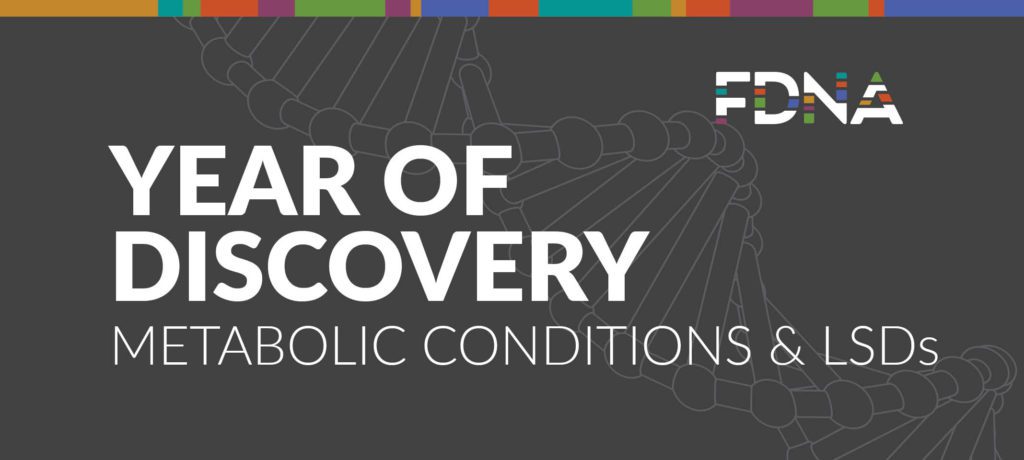Special thanks to ThinkGenetic for contributing to this post. This month, the Year of Discovery spotlights metabolic disorder and LSDs. Uploading cases of MPS, Fabry and other syndromes in this category to FDNA’s Face2Gene application can help accelerate advancements. Every time a case is analyzed by Face2Gene, the de-identified case data will train the system to recognize new phenotypes, facial characteristics and genes. For every case uploaded to Face2Gene in May, our lab sponsor, Blueprint Genetics, will donate $1* to the National MPS Society. Learn more at FDNA.com/YearofDiscovery.
Not too long ago it was taught in medical school that rare diseases were just that- rare and you probably wouldn’t see a patient with a rare disease in your practice. Individually, rare diseases have a low prevalence, but in aggregate, more than 8,000 chronically debilitating and life-threatening rare diseases impact 1 in 10 people.
Due to the lack of awareness and limited ability of physicians to diagnose these rare conditions, an average diagnostic journey takes over 7 years, during which patients see an average of 7 different specialists.
Inherited metabolic disorder are a classification of genetic diseases caused by a defect in a person’s genes. These conditions may also be referred to as inborn errors of metabolism (IEM). The majority of IEM are due to single gene defects that code for enzymes facilitating the conversion of substrates into waste products or by-products recycled by the cell. IEM is challenging for many physicians and with a collective incidence of 1:1,500 persons, there’s a high probability a patient with a metabolic disease will pass through almost all practicing physician’s clinics. When there is a loss of milestones, IEM should be high on the radar screen.
A further classification of inborn errors of metabolism is a group of diseases known as lysosomal storage diseases (LSDs). Again, while they may be individually rare, collectively they account for 1:7,700 live births.
It’s an exciting time in genetics, as advances in the diagnosis and treatment of many inborn errors of metabolism have improved the outlook for many of patients. Early diagnosis becomes very critical.
FDNA is working to partner with you in the Year of Discovery to help decrease the diagnostic journey for patients with these conditions. Together, we can make a difference.
Facial Phenotypes for MPS Diseases, Fabry and Homocystinuria
Mucopolysaccharidosis (MPS) Diseases – Shared clinical manifestations with all the MPS diseases include a chronic progressive course. The astute pediatrician can help expedite a diagnosis by recognizing a cluster of symptoms. Many of the MPSs are treatable. Facial dysmorphism may include:
- Macrocephaly
- Coarsening of facial features
- Broadened nose with flared nostrils
- Prominent supraorbital ridges
- Large jowls
- Thickened lips
- Macroglossia
- Corneal clouding- not usually present in Hunter syndrome
- Gingival hyperplasia
Fabry disease is one of the more common lysosomal storage diseases with a reported incidence of ~1:60,000. Fabry disease is X-linked and is treatable. While not a prominent sign, facial dysmorphism may include:
- Periorbital swelling
- Thinning lips
Homocystinuria is a metabolic condition whereby an enzyme, cystathionine beta-synthase (CBS), is needed to break down the amino acids methionine and homocysteine is deficient. Facial dysmorphism may include:
- Myopia
- Ectopia lentis
- Subtle dysmorphism in the form of frontal bossing
- High arched palate may be present
ThinkGenetic™ is a cutting-edge tool empowering patients who want to know about possible genetic causes for their medical issues or obtain real-life answers to their questions about the life-altering impact of their genetic diagnosis. The ThinkGenetic™(with IBM Watson ™) goal is to help speed time to diagnosis and reduce chances of diagnostic error — two things that can make a significant difference for millions around the world.
1 Meikle PJ, Hopwood JJ, Clague AE, Carey WF. Prevalence of lysosomal storage disorders. JAMA†. 1999;281:249–54.



